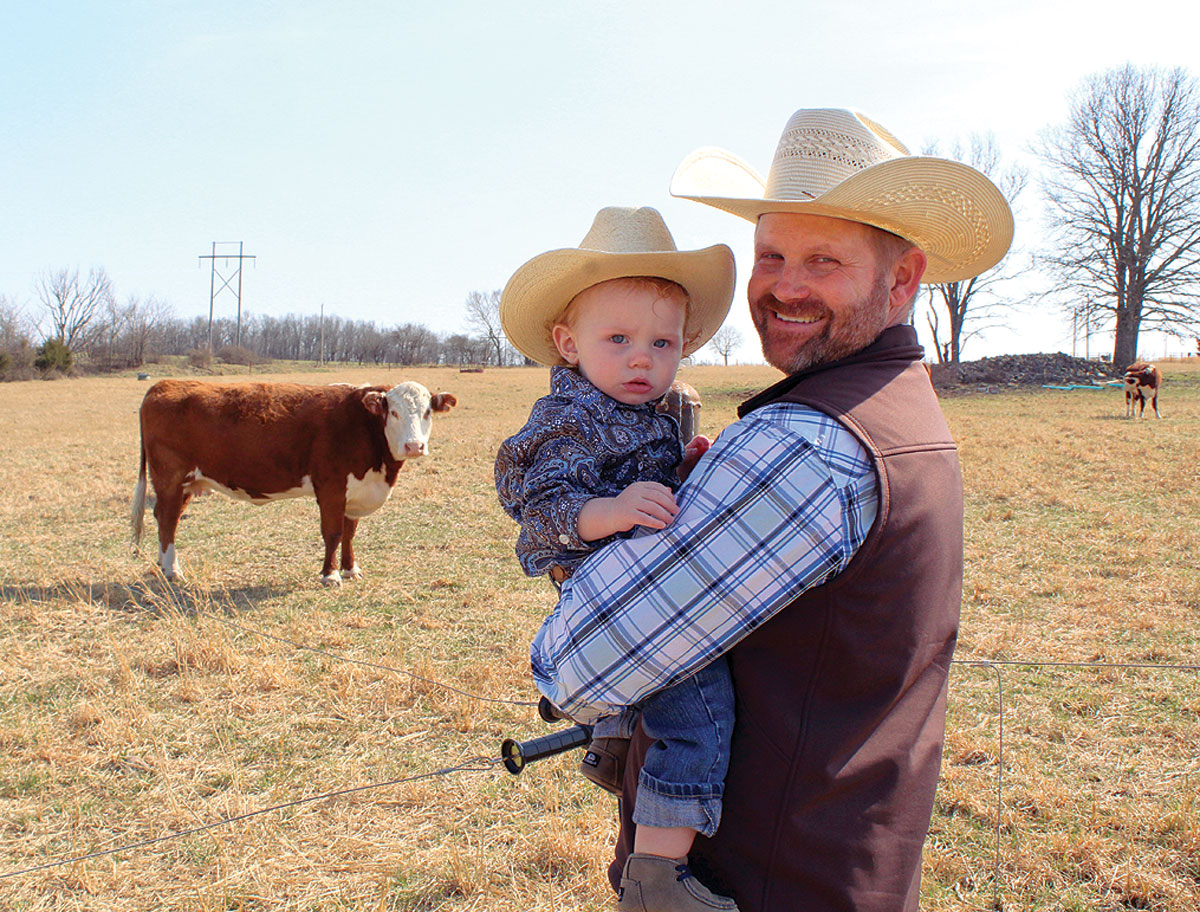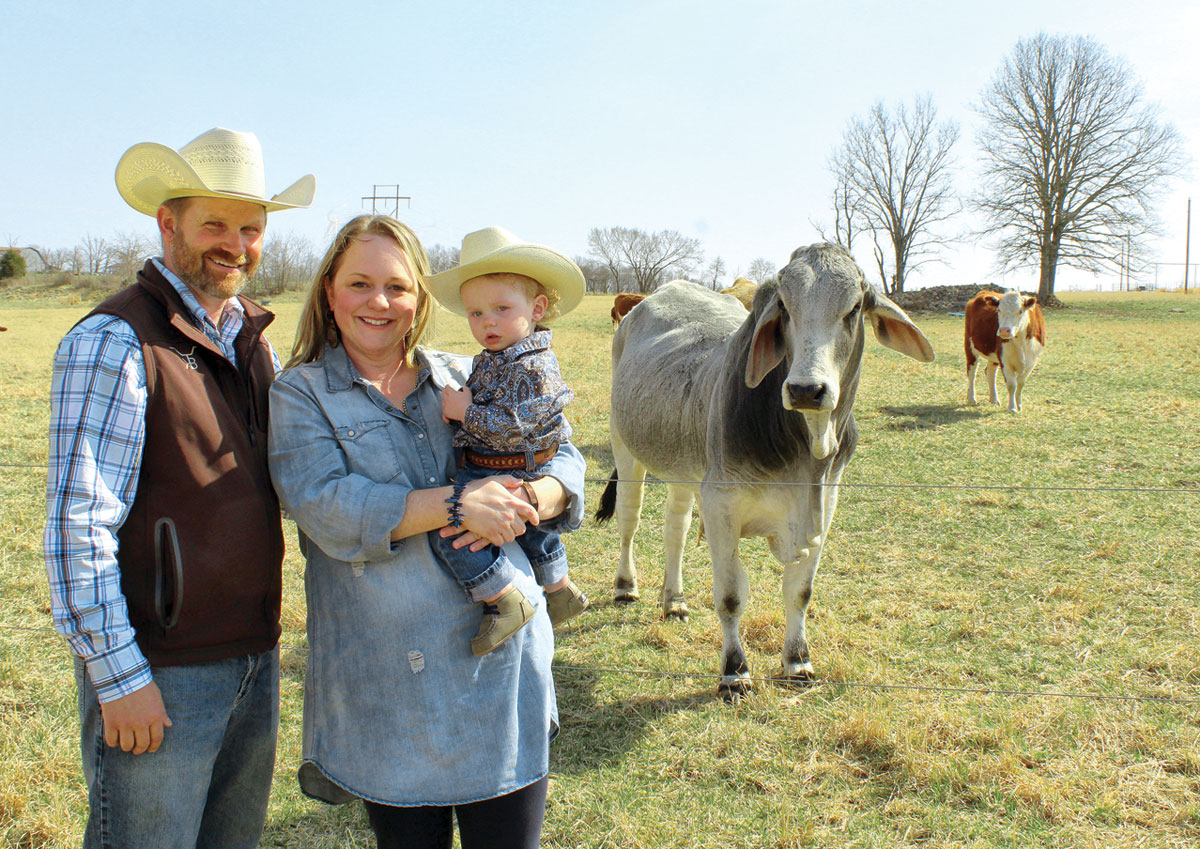
Trantham Farms appreciates the calving ease and growth of their Brahman and Hereford influenced cattle
Trantham Farms as it exists now is relatively new, but the cattle roots run long and deep in southern Howell County, Mo.
Bryan and Kala Trantham married five years ago but their families have been involved in the cattle industry for many years.
“My dad had cattle when I was younger and Kala’s family has always had cattle,” Bryan recalled. “Her family originally bought the place in 1924 and for two generations they operated a dairy farm. Now our son Cooper, who is just about to turn 1 year old, is the sixth generation on the farm.”
“It’s just something they have always done,” added Kala. “We spent summers here with my grandparents and have always had a close family, so once Bryan and I started our life together we realized we wanted to be on the farm too.”
They built a new house on the farm last fall and are now growing their herd.
“Cooper is our reason for moving to the farm. We want to be able to raise him close to family and for him to understand this life,” Kala said.
Herefords and Golden Certified F1
Tranthams raise registered Polled Hereford cattle along with the F1 cattle.
“We are a Golden Certified F1 breeder, which means our F1 animals are from registered animals on the dam and sire side. It is a registration through the American Brahman Breeders Association,” Bryan explained.
“We use our Herefords and cross them with a registered Brahman bull,” Kala said. “My brother, L.J., was the one who originally became interested in the F1 females. He got four or five head and really liked the animals he was producing. He passed away in 2013 from an ATV accident and we continued the F1 herd in honor of him.”
Bryan said they do things a little differently than the larger cattle producers.
“With smaller numbers, we utilize artificial insemination and we’re getting ready to do some embryo transfer work with our females,” Bryan said. “By utilizing the scientific opportunities available for beef cattle, we can get the best genetics in our herd and produce more offspring than normal with embryo transfer.
“We will use the F1 cows we raise as recipient cows in the embryo transfer program,” he added.
Bryan uses EPDs to help make his AI bull decisions and keeps the EPD records for his calves.
“By using Brahman bulls with our heifers, we have low-birth weight calves with big growth,” he explained. “This is good because we both have ‘regular jobs’ and need the cattle to be able to be as self-sufficient as possible,” Bryan chuckled.
“The F1 females are able to withstand the winters even though some weren’t sure they would be able to because they are primarily raised in the South where the winters are milder. They can adapt well to their environment. They also have good feet and eyes, and because they are conditioned for the heat, they continue to graze during the summer instead of just standing in the shade or pond during the heat,” Bryan explained. “I also like them for their longevity. You may get 10 to 12 years out of a straight bred female but F1s have been known to last up to 20 years.
“When we are breeding our registered Polled Herefords, we strive to raise bulls with the best genetics that will last. We look at teat size, udder size and all the other EPDs to make sure we are getting the best female traits through the bulls. We also just added a new bull to our herd. HCC TF 6039 King Cotton 8087F is our new Hereford AI herd sire and we look forward to the offspring he will produce.”
Additional Farming Techniques
Beside using AI and looking forward to ET, the Tranthams use rotational grazing to utilize their 40 acres for their Herefords and F1 cattle.
“We have seven paddocks divided up here and run the cattle on them for about one week each,” he said. “We also calve our registered cows in the fall. Then we don’t have to worry about the weather and the calves in the cold and snow.”
The Tranthams soil test their farm about every three years to make sure they are keeping the soil in the best condition for cattle production.
“We fertilize and I prefer to do this in the fall,” he said. “Of course, the cost of all this continues to go up, but it is something we need to do to keep the farm on the right track.”
Bryan also maintains the herd health himself.
“We have designed pens so I can work the cattle through myself if needed and I generally do the vaccinations, deworming, tagging and the basics,” he said. “Of course, we have the vet out if we have sickness or calving issue more than I can assist with.”
Advice and the Future
“If you are starting out, pay attention and preserve the ground you have. Don’t overstock and know what the land can handle,” Bryan explained. “Start small and grow as you can.
“It’s also good to look for what works well for you and find your niché. There is always something different out there to explore. F1 animals are plentiful down South, but we didn’t know if the F1 bulls would work around here and people would want eared cattle.
“We’ve had good luck and have even been contacted about consigning cattle to a Brahman-influenced sale in the next few years,” Bryan added. “So, don’t be afraid to try new things. You might find something exactly right for your situation.”
Family
At the end of the day, it all comes back to family for the Tranthams.
“When we lost my brother, it was a tough time and things were getting a little mundane around the farm,” Kala explained. “When Bryan and I got married and then Cooper was born, he brought life back to us. My brother used to live with my grandma and now she helps watch Cooper along with my mom, so he has been a true blessing to us all.”
“He loves the cows and anytime we go out and he hears the tractor or the Gator start up, he wants to go,” added Bryan.







